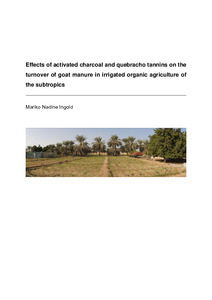| dc.date.accessioned | 2015-04-15T07:43:07Z | |
| dc.date.available | 2015-04-15T07:43:07Z | |
| dc.date.issued | 2015-04-15 | |
| dc.identifier.uri | urn:nbn:de:hebis:34-2015041548103 | |
| dc.identifier.uri | http://hdl.handle.net/123456789/2015041548103 | |
| dc.description.sponsorship | We thank the Royal Court Affairs (Royal Gardens and Farms), Sultanate of Oman, for its support and the German Research Foundation (DFG) for funding this research within the Research Training Group 1397 “Regulation of Soil Organic Matter and Nutrient Turnover in Organic Agriculture” at University of Kassel, Germany. | eng |
| dc.language.iso | eng | |
| dc.rights | Urheberrechtlich geschützt | |
| dc.rights.uri | https://rightsstatements.org/page/InC/1.0/ | |
| dc.subject | Activated charcoal | eng |
| dc.subject | Carbon and nitrogen turnover | eng |
| dc.subject | Goat manure | eng |
| dc.subject | Mineralization | eng |
| dc.subject | Quebracho tannins | eng |
| dc.subject | Subtropics | eng |
| dc.subject | Irrigated agriculture | eng |
| dc.subject.ddc | 630 | |
| dc.title | Effects of activated charcoal and quebracho tannins on the turnover of goat manure in irrigated organic agriculture of the subtropics | eng |
| dc.type | Dissertation | |
| dcterms.abstract | Agriculture in semi-arid and arid regions is constantly gaining importance for the security of the nutrition of humankind because of the rapid population growth. At the same time, especially these regions are more and more endangered by soil degradation, limited resources and extreme climatic conditions. One way to retain soil fertility under these conditions in the long run is to increase the soil organic matter. Thus, a two-year field experiment was conducted to test the efficiency of activated charcoal and quebracho tannin extract as stabilizers of soil organic matter on a sandy soil low in nutrients in Northern Oman. Both activated charcoal and quebracho tannin extract were either fed to goats and after defecation applied to the soil or directly applied to the soil in combination with dried goat manure. Regardless of the application method, both additives reduced decomposition of soil-applied organic matter and thus stabilized and increased soil organic carbon. The nutrient release from goat manure was altered by the application of activated charcoal and quebracho tannin extract as well, however, nutrient release was not always slowed down. While activated charcoal fed to goats, was more effective in stabilising soil organic matter and in reducing nutrient release than mixing it, for quebracho tannin extract the opposite was the case. Moreover, the efficiency of the additives was influenced by the cultivated crop (sweet corn and radish), leading to unexplained interactions. The reduced nutrient release caused by the stabilization of the organic matter might be the reason for the reduced yields for sweet corn caused by the application of manure amended with activated charcoal and quebracho tannin extract. Radish, on the other hand, was only inhibited by the presence of quebracho tannin extract but not by activated charcoal. This might be caused by a possible allelopathic effect of tannins on crops. To understand the mechanisms behind the changes in manure, in the soil, in the mineralisation and the plant development and to resolve detrimental effects, further research as recommended in this dissertation is necessary. Particularly in developing countries poor in resources and capital, feeding charcoal or tannins to animals and using their faeces as manure may be promising to increase soil fertility, sequester carbon and reduce nutrient losses, when yield reductions can be resolved. | eng |
| dcterms.accessRights | open access | |
| dcterms.creator | Ingold, Mariko Nadine | |
| dc.contributor.corporatename | Universität Kassel, Fachbereich Ökologische Agrarwissenschaften | |
| dc.contributor.referee | Bürkert, Andreas | |
| dc.subject.swd | Holzkohle | ger |
| dc.subject.swd | Kohlenstoff | ger |
| dc.subject.swd | Stickstoff | ger |
| dc.subject.swd | Umsatz <Biochemie> | ger |
| dc.subject.swd | Ziege | ger |
| dc.subject.swd | Stallmist | ger |
| dc.subject.swd | Quebracho | ger |
| dc.subject.swd | Tannine | ger |
| dc.subject.swd | Subtropen | ger |
| dc.subject.swd | Bewässerungswirtschaft | ger |
| dc.date.examination | 2014-11-21 | |

